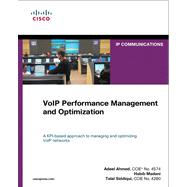VoIP Performance Management and Optimization
A KPI-based approach to managing and optimizing VoIP networks
IP Communications
Adeel Ahmed, CCIE® No. 4574
Habib Madani
Talal Siddiqui, CCIE No. 4280
VoIP Performance Management and Optimization is the first comprehensive, expert guide to managing, monitoring, troubleshooting, and optimizing large VoIP networks. Three leading Cisco VoIP experts bring together state-of-the-art techniques for ensuring that customer service level agreements (SLA) are consistently met or exceeded.
The authors begin by reviewing how VoIP is deployed in enterprise and service provider networks and the performance tradeoffs and challenges associated with each leading VoIP deployment model. Next, they present a comprehensive approach to diagnosing problems in VoIP networks using key performance indicators (KPI) and proactively addressing issues before they impact service.
In this book, you will find a proven tools-based strategy for gauging VoIP network health and maximizing performance and voice quality. You also will learn how to perform trend analysis and use the results for capacity planning and traffic engineering—thereby optimizing your networks for both the short- and long-term.
The authors all work in the Cisco Advanced Services Group.
- Deploy, manage, monitor, and scale multivendor VoIP networks more effectively
- Integrate performance data from multiple VoIP network segments and service flows to effectively manage SLAs
- Use performance counters, call detail records, and call agent trace logs to gauge network health in real time
- Utilize dashboards to analyze and correlate VoIP metrics, analyze trends, and plan capacity
- Implement a layered approach to quickly isolate and troubleshoot both localized and systemic problems in VoIP networks
- Optimize performance in networks where the service provider owns the “last mile” connection
- Improve performance when VoIP is deployed over publicly shared infrastructure
- Manage performance in enterprise networks using both centralized and distributed call processing
- Plan media deployment for the best possible network performance
- Monitor trends, establish baselines, optimize existing resources, and identify emerging problems
- Understand and address common voice quality issues
This IP communications book is part of the Cisco Press® Networking Technology Series. IP communications titles from Cisco Press help networking professionals understand voice and IP telephony technologies, plan and design converged networks, and implement network solutions for increased productivity.
Category: Networking: Unified Communications
Covers: Voice over IP Network Management








